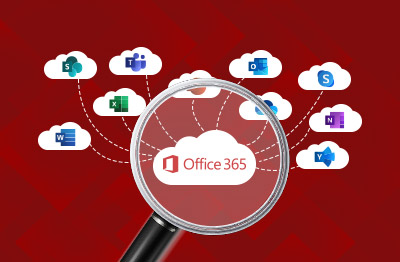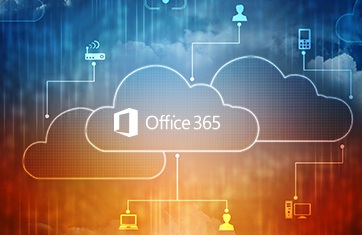What is Office 365?
Microsoft Office 365 is a powerful cloud-based productivity platform that includes apps like Microsoft Teams, Word, Excel, PowerPoint, Outlook and OneDrive, as well as intelligent cloud services and advanced security.
The main difference between Microsoft Office 365 and the software giant’s previous offerings is that it’s a subscription service. It provides the same productivity tools you have come to love.
Office 365 applications
There is a wealth of productivity apps available and each one serves a unique purpose. Most people know the more common apps and their uses. See below for some of those not discussed nearly as often:
- Outlook: One of the most used apps in the Microsoft Office 365 suite, Outlook is Microsoft’s email client. This powerful app allows you to customize emails, create templates, flag emails for follow up, schedule meetings, and so much more. With Microsoft 365, IT organizations no longer need to have a Microsoft Exchange server on-premises. Microsoft maintains and operates Exchange Online. Organizations need to configure Outlook clients to access Exchange Online.
- Microsoft SharePoint: SharePoint is the main component of Office 365 that makes collaboration possible. In addition to file sharing and organization, it includes SharePoint Workflows, SharePoint PerformancePoint, and SharePoint project sites. Together, these apps facilitate sharing and managing data around the world. As with email, the Microsoft IIS, SharePoint servers and Microsoft SQL database servers needed to provide collaboration services are operated by Microsoft. IT organizations can administer and manage the collaboration services without having to worry about maintaining these servers, patching them at regular intervals, upgrading the software, etc. All these activities are handled by Microsoft as part of their SaaS offering.
- Teams: Use Teams to chat with coworkers, collaborate on projects, share files, and provide real-time updates on tasks. Teams has replaced Skype for Business. So, this is where you have virtual meetings with your colleagues and coworkers.
- Yammer: Yammer is a unique social networking service designed with enterprise communication in mind. Yammer helps employees get answers fast even when they don’t know whom to ask. Yammer enables organizations—particularly ones with multiple offices—to collaborate across locations. Instead of sending an email asking whom to ask about a topic, you can now just post it on a Yammer Group. Department heads keep an eye on their Yammer groups and respond to questions accordingly. Employees get the answers they need, and work gets done faster.
- Microsoft Forms: This app allows you to create questionnaires, quizzes, surveys, and other data collection tools. Once collected, you can transfer the data on to other notable applications, such as Excel. This app is excellent for market research or to collect data among your teammates.
- Microsoft OneNote: This app is great for taking notes during meetings and sketching out ideas by hand. These notes are shareable with your whole team, which makes collaboration easy. You can also access your notes across all your devices.
- Microsoft Publisher: This app is similar to Word, but the focus is different. Word focuses on the text of the document whereas Publisher focuses more on the layout and overall design. This app is popular among marketers.
- MyAnalytics: Use this dashboard to see your Microsoft Office 365 productivity. Track how many hours you spend in meetings, chatting with coworkers, and sending emails. You can even use this app to automatically schedule “focus hours” on your calendar to allow for uninterrupted work.
Office 365 cost
There are two payment plans to choose from: annual and monthly. There are also different plans based on usage, such as small business, enterprise, school, and non-profit. Each has its own pricing. Microsoft also provides a small discount for choosing annual billing over monthly billing.
Office 365 monitoring
Microsoft Office has played an indispensable role in the workplace for decades. As long as Microsoft servers and applications were deployed on-premises, IT administrators had complete visibility. However, with Office 365 being a SaaS service, administrators no longer can track the CPU usage of their servers, the queues on their applications, etc.
eG Enterprise comprehensive monitoring, diagnosis and reporting for Office 365 services. With eG Enterprise, administrators get:
- 360-degree view of user experience using a combination of synthetic and real user monitoring, proactive alerts can be generated highlighting potential bottlenecks
- A means to track the health of O365 services by using Microsoft APIs, so that eG Enterprise can be a single unified console providing insights into all aspects of O365 performance
- To measure the usage of Microsoft O365 services by integrating with Microsoft APIs. Administrators can be notified when actual usage exceeds pre-configured limits (for example, OneDrive usage reaching quota for a user)
- Security and compliance tracking to assist with early detection of malware, spam, and other malicious activities
- Monitoring of the on-premises infrastructure used to access O365: this includes the network interconnection from the customer location to O365 data centers, Active Directory, and other infrastructure services as well as user laptops/desktops. This allows administrators to pinpoint where the root-cause lies when there is a problem.
eG Enterprise delivers best-in-class digital experience for your Office 365 users by enabling you to triage and resolve O365 performance issues even before your users and business are affected.


